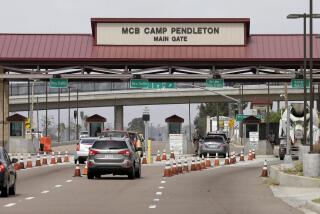5 Tustin Marines Killed in Helicopter Crash : Super Stallion Plunges Into Desert Floor
- Share via
A Marine Corps helicopter from Tustin slammed into the ground and burned near the Salton Sea Thursday night, killing all five crew members, officials said.
Marine Corps officials said the craft went down in open desert in the Salton Sea Test Range in Imperial County, seven miles south of Salton City, about 8:30 p.m. during practice nighttime landings for troop deployment.
The fiery crash is the latest in a series of accidents involving the CH-53E Super Stallion, which has been the target of a congressional investigation.
The three-engine helicopter, manufactured by Sikorsky Aircraft Co. of Stratford, Conn., costs $16 million and is America’s largest helicopter. It can carry as many as 55 combat soldiers, lift 16 tons of equipment and is sometimes used for naval minesweeping operations.
The Marine Corps declined Friday to speculate on the cause of the crash and said a team composed of squadron members from the Tustin Marine Corps Air Station will investigate. However, Rep. Robert E. Badham (R-Newport Beach), who initiated the congressional investigation, said preliminary evidence points to pilot error.
‘Hit the Ground Too Hard’
“There’s no indication that there was anything that was wrong with the aircraft mechanically,” Badham said. “The bird just didn’t fall from the sky. It was entering the landing zone in night troop exercises and hit the ground too hard, flipped over and burned. The first reports we got from the Marine Corps indicated that there was no mechanical difficulty, and if it’s not mechanical, it’s got to be human. . . . That’s the presumption I would make at this time.”
All members of the crew had been living in Orange County but had come from throughout the United States.
The Marine Corps identified the pilot as Maj. David J. Brandenburg, 34, of Mission Viejo, who had lived in Sacramento. The co-pilot was 1st Lt. Michael T. Reilly, 29, of Laguna Hills, who was from Taunton, Mass.
Also on board were Lance Cpls. Gregory L. Michaels, 19, of Tustin and Frenchville, Pa., and Thomas H. Baddeley III, 21, of Tustin and Yardley, Pa., as well as Cpl. Mark B. Burris, 21, of Tustin, whose hometown was Toronto, Ohio.
The crash site is a mile north of the intersection of Highways 78 and 86, about half a mile from the edge of the Salton Sea.
From the sky, only a part of the tail section was recognizable in the wreckage,, which lay on a strip of scorched desert soil.
At the crash site were a military tent, several trucks, and some helicopters parked away from the site. The wreckage area was ringed with yellow tape. An ambulance drove slowly from the crash site to a waiting military helicopter.
The bodies were flown to Yuma and are scheduled to be transferred to San Diego, according to a Marine Corps spokesman.
Since 1984, the Super Stallion helicopter has been involved in six fatal crashes in which 24 Marines have been killed, 17 of them from squadrons based at Tustin.
Before Thursday night’s crash, the most recent incident involved a Super Stallion that made a precautionary landing in an Irvine farm field Oct. 22 after encountering transmission problems.
Badham, a member of the House Armed Services Committee, asked for a congressional investigation of the Super Stallion shortly after four crew members died during a training flight at Twentynine Palms last May.
The inquiry is complete except for the Marine Corps’ report on the cause of the Twentynine Palms crash, Badham said Friday.
‘Complex Aircraft’
“I’m somewhat certain that we will find that there is no inherent manufacturing or design flaw in the aircraft,” Badham said of the congressional investigation. “But we will also conclude that it’s a very complex aircraft. . . . It’s a lot of helicopter, and it is unforgiving. . . . All of the training has to be very, very fine tuned.”
Badham said he was referring to the helicopter’s weight, size and speed.
Although several incidents have involved transmission problems, Badham said the congressional inquiry so far has determined that “there is no common link between the crashes. So we’re trying to ascertain what can be done to reduce the risk, whatever the cause. The reason I instigated the study is because we have a morale factor to consider, we have a loss of life that we cannot afford.”
Badham said he hoped that Thursday night’s crash would not renew the controversy over the helicopter’s safety.
“I would hope not,” the congressman said. “There’s nothing to suggest now or in the past that there should be a general grounding. . . . If I have my druthers, this one (Thursday’s crash) will not be included in that (congressional) report, simply from a timeliness factor. We should put that report to bed and move on.”
Likely to Prolong Debate
But Marine Corps officials acknowledged Friday that the latest crash is likely to prolong debate about the aircraft.
“It is a program on which there have been a lot of reported problems,” Navy Lt. Cmdr. Kevin Mukri told the Associated Press Friday.
In addition to transmission problems, the helicopters have experienced difficulties with the tail rotor drive assemblies, said Marine Corps officials.
Sikorsky recently produced 56 of the helicopters for the military, under a $742-million contract.
A company spokesman said Friday that the firm has “the greatest confidence” in the safety of the helicopter despite Thursday’s crash.
Times staff writers Bill Billiter, Steve Emmons and Mark I. Pinsky contributed to this story.
More to Read
Sign up for Essential California
The most important California stories and recommendations in your inbox every morning.
You may occasionally receive promotional content from the Los Angeles Times.













